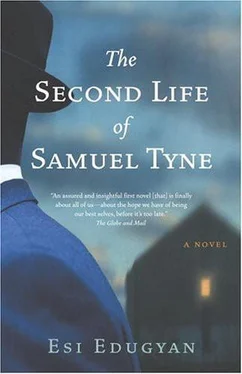Esi Edugyan - The Second Life of Samuel Tyne
Здесь есть возможность читать онлайн «Esi Edugyan - The Second Life of Samuel Tyne» весь текст электронной книги совершенно бесплатно (целиком полную версию без сокращений). В некоторых случаях можно слушать аудио, скачать через торрент в формате fb2 и присутствует краткое содержание. Год выпуска: 2005, Издательство: Vintage Canada, Жанр: Современная проза, на английском языке. Описание произведения, (предисловие) а так же отзывы посетителей доступны на портале библиотеки ЛибКат.
- Название:The Second Life of Samuel Tyne
- Автор:
- Издательство:Vintage Canada
- Жанр:
- Год:2005
- ISBN:нет данных
- Рейтинг книги:4 / 5. Голосов: 1
-
Избранное:Добавить в избранное
- Отзывы:
-
Ваша оценка:
The Second Life of Samuel Tyne: краткое содержание, описание и аннотация
Предлагаем к чтению аннотацию, описание, краткое содержание или предисловие (зависит от того, что написал сам автор книги «The Second Life of Samuel Tyne»). Если вы не нашли необходимую информацию о книге — напишите в комментариях, мы постараемся отыскать её.
That new beginning didn’t live up to Samuel’s expectations. As the novel opens fifteen years later, he is working as an economic forecaster for the government in Calgary. It’s a stiflingly bureaucratic, dead-end job, where petty managerial types and lifeless co-workers make Samuel’s days almost unbearable.
Everything changes for Samuel when he finds out that his Uncle Jacob has died. Samuel and his uncle had grown apart. They had not spoken for a number of years, though Jacob had raised Samuel and, in a way, sacrificed himself for Samuel’s future. Jacob’s death weighs heavily on Samuel, yet his reaction seems more about having “a singular chance to get all his sadness out” than about familial love. Samuel is jolted out of his sadness and his workaday world when he receives a call telling him he has inherited Jacob’s old mansion in the small town of Aster, Alberta. The town, originally settled by freed slaves from Oklahoma, sounds to Samuel like the perfect place to start a new life, one that would allow him to live up to his potential, and he decides to exchange the drudgery of the city for the simplicity of small-town existence. When Samuel leaves his office for good after yet another minor humiliation, we cheer his resolve and look forward to what the coming days will bring.
Samuel believes that he is setting on a path to fulfill his personal expectations, but we begin to see the signs of what one reviewer has called Samuel’s “pathological temerity.” He doesn’t tell his family what has happened: not that he’s inherited the house, or that he plans to move there or even that he’s quit his job. Instead, he spends his days tinkering in the shed, emerging at just the right time to make it seem like he’s coming home from work. The truth comes out only when one of his daughters discovers his secret. His deception points to a paralyzing inability to communicate with others and suggests that this new beginning may be as fruitless as the last.
Maud and the twins, Chloe and Yvette, resist the move to Aster, but are helpless in the face of Samuel’s conviction that this is the right thing to do. And when they arrive, their new home — a gloomy, worn-down remnant of days long past — doesn’t exactly fill them with hope. But the seeds of renewal have been sown, the move has been made and they hesitantly take up their new lives. At first, the Tynes seem to be settling in — they meet some of their neighbours, Samuel sets up his own electronics shop, Maud begins to fix up the house and the twins are curious enough to at least begin exploring their new home. However, the idealized Aster of Samuel’s imagination proves to be as false as his family’s veneer of acceptance, and a dark undercurrent of small-mindedness, racism and violence soon turns on the town’s newest residents. When mysterious fires begin to destroy local buildings, and the bizarre yet brilliant twins retreat into their own dark world, Samuel’s fabled second chance slips slowly out of his grasp.
The Second Life of Samuel Tyne












